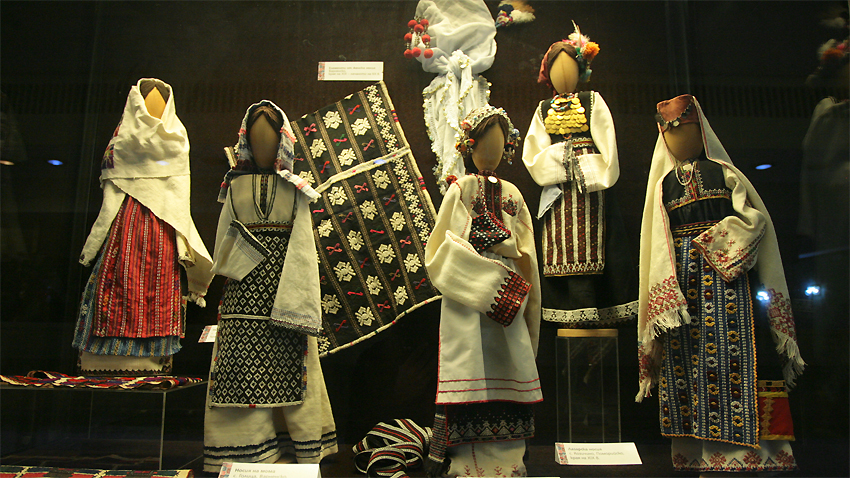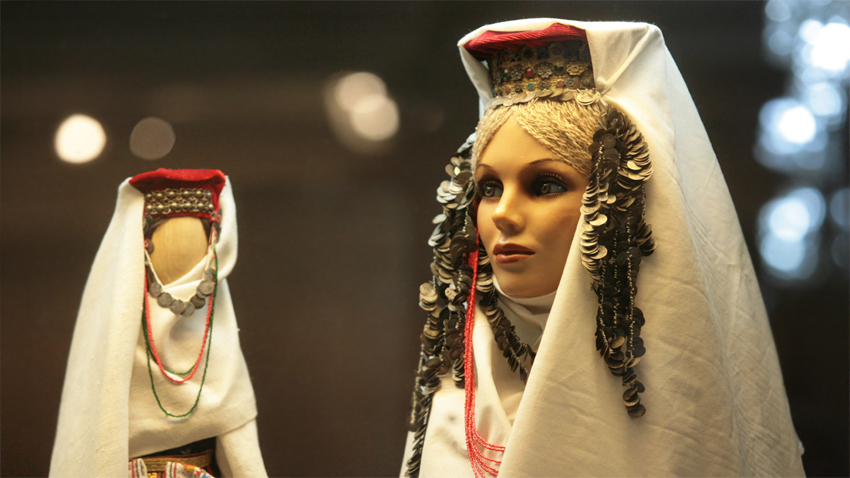 3
3
An exhibition is on at the National Museum of History with the motto “Creativity recreated”. It displays splendid embroidery pieces from the Bulgarians lands, as well as traditional costumes and jewelry. A wealth of traditional folk costume designs from various regions is shown in downsized versions on dolls. More about the display from curator Antoaneta Ivanova:

„Embroidery pieces are typical of aprons, tunics and shirts. The costumes in downsized versions were designed in the 1980s by Antonia Vevela. She was a restorer in the museum, and based her work on the travel notes of famous traveler, ethnographer and geographer Felix Kanitz, as well as on the works of great artist Ivan Mrkvicka. Also, the works of leading ethnographer Maria Veleva have provided precious reference. The exhibition shows two-apron garments, tunics and saya frocks characteristic of western Bulgaria. On display are folk costumes from the regions of Pleven, Sofia, Stara Zagora, Northeastern Bulgaria, the Rhodope Mountains, Bansko and other regions. In each showcase we feature replicas of dolls with traditional costumes and embroidery pieces are the originals.”
 For the first time the visitors can also see a reenactment of the so-called sokayhead covering. The sokay is a kind of a diadem used by married women in the central Bulgarian regions of Gabrovo, Tryavna, Veliko Tarnovo, Sevlievo and Kilifarevo. It consists of a wooden pad, a white headscarf decorated with embroidery. Also, there is another jewel - the krazhilo that has metal decorations such as small coins. Some researchers find the roots of the sokay head covering in the royal and boyar costumes in the Second Bulgarian Kingdom (1185 - 1396). The sokay is given to the young bride by her mother-in-law as a token of continuity. The more affluent the bridegroom's family, the bigger the adornments applied while covering the head.
For the first time the visitors can also see a reenactment of the so-called sokayhead covering. The sokay is a kind of a diadem used by married women in the central Bulgarian regions of Gabrovo, Tryavna, Veliko Tarnovo, Sevlievo and Kilifarevo. It consists of a wooden pad, a white headscarf decorated with embroidery. Also, there is another jewel - the krazhilo that has metal decorations such as small coins. Some researchers find the roots of the sokay head covering in the royal and boyar costumes in the Second Bulgarian Kingdom (1185 - 1396). The sokay is given to the young bride by her mother-in-law as a token of continuity. The more affluent the bridegroom's family, the bigger the adornments applied while covering the head.
„Head covering for young girls used to be beautiful but not as colorful as the one for married women. The exhibition also shows embroidery that was specifically applied to aprons, as well as embroidery for shirts, the neckline, sleeves and tunics.”

Of course, on festive days for the community, the Bulgarians of pre-modern time wore clothes with a great diversity of embroideries and ornaments. The special festive costumes were more colorful and girls felt proud to dress up and demonstrate how they have decorated their clothing.
English Daniela Konstantinova
Photos: BGNES and Veneta PavlovaBulgarian visual artist and graphic designer Radoslava Boor, who has been developing a career between Sofia and Prague for years, has been awarded the BIPB Award . The Bulgarian Embassy in South Korea announced this on its website. The..
The exhibition “Childhood Years” at the Center for Contemporary Art “Christo and Jeanne-Claude” in Gabrovo will open the autumn season of the Bulgarian Cultural Institute in Paris on September 19 at 6 p.m. local time. God is not Bulgarian, but..
The exhibition “Sofia - Istanbul: Bridge of Art” will be presented from December 4 to January 3, 2026, at the gallery of the Union of Bulgarian Artists in Sofia , the organizers announced. The project promotes long-term cultural cooperation and artistic..
Bulgarian visual artist and graphic designer Radoslava Boor, who has been developing a career between Sofia and Prague for years, has been awarded the..
The exhibition “Childhood Years” at the Center for Contemporary Art “Christo and Jeanne-Claude” in Gabrovo will open the autumn season of the Bulgarian..

+359 2 9336 661
